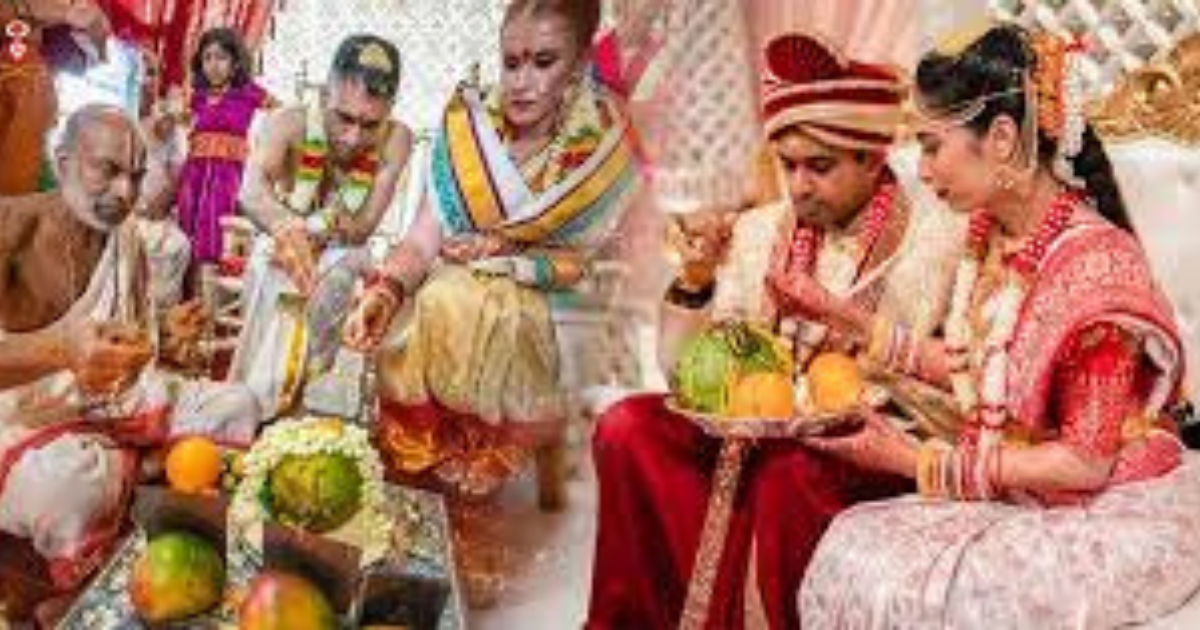In Indian culture, weddings are not merely the union of two individuals but a sacred bond that brings together two families. To ensure the ceremony proceeds without obstacles, many Hindu families begin the wedding festivities with Ganesh Puja. This ritual invokes Lord Ganesha, the remover of obstacles and the god of new beginnings, to bless the couple and their families with a harmonious and auspicious start. Here is a comprehensive, step-by-step guide to performing Ganesh Puja before a wedding.
Importance of Ganesh Puja Before a Wedding
Ganesh Puja holds immense significance in Hindu traditions, especially before a wedding. The ritual is believed to:
- Remove Obstacles: Lord Ganesha, also known as Vighnaharta, clears any hindrances that could impact the marriage.
- Ensure Prosperity: His blessings are said to bring happiness, success, and prosperity to the newlyweds.
- Promote Harmony: The puja fosters unity and understanding between the two families.
- Auspicious Beginning: Starting the wedding festivities with Ganesh Puja sets a positive and sacred tone for the events ahead.
Preparations for Ganesh Puja
Before performing the puja, careful planning and preparation are essential to ensure everything proceeds smoothly. Here are the steps to prepare:
1. Choose an Auspicious Date and Time
Consult a family priest or astrologer to determine the shubh muhurat (auspicious time) for performing Ganesh Puja. The timing often depends on the bride and groom’s horoscopes.
2. Create a Sacred Space
Set up a clean and quiet area where the puja will take place. Decorate the space with flowers, rangoli, and other traditional elements.
3. Gather Puja Items
Ensure you have the following items ready:
- Idol or image of Lord Ganesha
- Kalash (holy water pot)
- Fresh flowers and garlands
- Incense sticks and diya (oil lamp)
- Kumkum (vermilion), haldi (turmeric), and rice
- Betel leaves and nuts
- Coconut
- Fruits, sweets (like modaks), and other offerings
- Red or yellow cloth to drape the idol
- Durva grass (sacred grass) and mango leaves
4. Invite a Priest
Although families can perform the puja themselves, it is traditional to invite a priest who knows the rituals and mantras.
Step-by-Step Ganesh Puja Ceremony
Step 1: Purification (Shuddhi)
Before starting the puja, purify the space and the participants. Sprinkle holy water around the area and on everyone present to cleanse any negative energies.
Step 2: Establishing the Kalash
Place the kalash filled with water in front of the idol. Cover it with a coconut and mango leaves. The kalash represents the universe and is an integral part of Hindu rituals.
Step 3: Placement of Lord Ganesha’s Idol
Drape the idol or image of Lord Ganesha with a clean red or yellow cloth. Offer flowers, garlands, and durva grass to the deity.
Step 4: Invocation (Avahana)
Invoke Lord Ganesha by chanting his mantras. The priest or head of the family performs this step by folding hands and offering prayers:
Mantra Example: Vakratunda Mahakaya Suryakoti Samaprabha | Nirvighnam Kuru Me Deva Sarva-Kaaryeshu Sarvada ||
This mantra calls upon Lord Ganesha to bless the ceremony and remove all obstacles.
Step 5: Offering to Lord Ganesha
Offer items such as modaks, fruits, betel leaves, and sweets to the deity. Light incense sticks and the diya, symbolizing purity and devotion.
Step 6: Aarti and Prayers
Perform the aarti (a ritual of waving a lit lamp) while singing devotional songs in praise of Lord Ganesha. This step involves circling the lamp in front of the idol while everyone present joins in chanting.
Step 7: Reciting the Sankalp
The sankalp is a vow or intention taken by the family to perform the puja with sincerity and devotion. The priest guides the family in making this declaration, stating the purpose of the ritual and seeking blessings for the couple.
Step 8: Offering Dakshina
Conclude the ceremony by offering dakshina (a token of appreciation) to the priest. Seek his blessings for the bride and groom.
Symbolic Significance of Ritual Elements
Each aspect of Ganesh Puja holds deep symbolism:
- Durva Grass: Represents humility and devotion.
- Modaks: Symbolize sweetness and the fulfillment of desires.
- Kalash: Represents the cosmos and abundance.
- Coconut: Denotes purity and the human soul.
Common Mistakes to Avoid
- Skipping the Muhurat: Performing the puja at the wrong time may diminish its auspiciousness.
- Inadequate Preparation: Ensure all items are ready to avoid disruptions during the ceremony.
- Distractions: Maintain a solemn and respectful atmosphere throughout the ritual.
- Overlooking Ritual Details: Follow each step carefully, as even minor oversights may affect the sanctity of the ceremony.
Benefits of Ganesh Puja Before a Wedding
Performing Ganesh Puja before a wedding brings numerous benefits:
- It eliminates obstacles that may arise during the wedding or in married life.
- It blesses the couple with a prosperous and harmonious future.
- It creates a positive spiritual environment for the upcoming ceremonies.
- It strengthens familial bonds through shared participation in the sacred ritual.
Modern Adaptations
In today’s fast-paced world, some families opt for simplified versions of Ganesh Puja. While it’s acceptable to adapt certain elements to suit modern lifestyles, it is essential to retain the essence and devotion of the ritual. For instance:
- Virtual pujas via video conferencing for family members who cannot attend in person.
- Using eco-friendly idols and materials to honor environmental concerns.
Conclusion
Ganesh Puja before wedding is more than a ritual; it is a heartfelt prayer for divine guidance and blessings. By following this step-by-step guide, families can ensure a meaningful and auspicious start to the wedding festivities. Embrace the traditions with devotion and sincerity, and let the blessings of Lord Ganesha pave the way for a joyous and prosperous marital journey.
Frequently-Asked Questions (FAQS)
Why is Ganesh Puja performed before a wedding?
Ganesh Puja is performed to seek Lord Ganesha’s blessings for removing obstacles, ensuring a smooth wedding process, and starting the new chapter in the couple’s lives on an auspicious note.
What are the essential items needed for Ganesh Puja before a wedding?
Essential items include an idol or image of Lord Ganesha, kalash (holy water pot), flowers, incense sticks, diya, turmeric, vermilion, betel leaves, coconut, modaks, fruits, and sacred grass (durva).
Who can perform Ganesh Puja before a wedding?
While a priest traditionally conducts the puja, family members can also perform it if they are familiar with the rituals and mantras.
How long does a typical Ganesh Puja ceremony last?
A Ganesh Puja ceremony usually lasts between 30 minutes to an hour, depending on the rituals and mantras included.
Can Ganesh Puja be performed virtually or with modern adaptations?
Yes, families can adapt the ceremony to modern circumstances, such as hosting it virtually for distant relatives or using eco-friendly idols and simplified rituals while maintaining devotion and sincerity.




